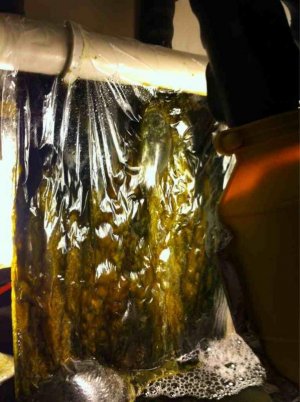We should discuss learning to balance an algae scrubber. Knowing how could help others troubleshoot their own systems. You are designing and building a filter. Building an algae scrubber is not very hard but small defects in your build can create issues right away or later on down the road.
That also being said, I still am learning new things about algae scrubbing every day. I don't know everything and some of what I wrote here may not be completely accurate. I ask that others comment, correct or back this brief write up.
The reason for the write up allows someone to design a different system, shape, style etc.
After almost a year of tweaking and learning to balance an algae scrubber, I have learned the following to be true for me. (my tank)
Light, flow and real-estate (screen) need to be kept in balance. Overdoing anyone of these, including screen size can inhibit growth. Encourage the wrong algae to grow, or worse... Depending how far things are off balance.
Lighting issues: (assumes flow and real estate are balanced.)
Too much light can create yellow or clear-ish algae growth, even more light will prevent growth all together. this is true if the lights are too close or too intense AND run too long
Not enough light will grow dark algae, slimy, or other forms. Even less light and you will get gray to black growth (very bad) ...and should be cleaned every 3 days
Uneven light will grow hot spots, or dark edges. Or stripes that flow bulb placement.
This is why you need light a certain number of inches away, Need to replace bulbs every 3 months, Or why certain bulbs are unfit for the job.
About 375 - 500 PAR is ideal
Light should be spread evenly across the screen, when using spiral CFLs this can be difficult due to hot spots and/or dark edges.
(still waiting for confirmation on PAR requirements)
Flow issues: (assumes light and real estate in balance.)
Too much flow can make splatters or streaming occur. It can make algae fall off your screen when roots aren't strong enough for new growth. Can also create dark stripes. Even more flow and the ideal algae may never be able to attach and grow.
Not enough flow will create slow strips, grow discolored unwanted algae. Even less flow and dark to black algae will grow...
Main reason to actually test flow coming from your pump, with actual head pressure.
35GPH per inch of screen width.
Straight cut slot tube helps keep flow even.
Screen issues: (assumes light and flow in balance.)
Too large and unwanted algae will grow in lower lit areas (dark or black growth still possible in these areas), competing with wanted algae. Less of an issue so long as healthy growth covers most if the screen. Too large of a screen and projected needs for light and flow will create other issues. Notice this is over a year old, and now this is the exact reason why smaller screen, sized to feeding, are more effective
Too small a screen and nitrogen and phosphate aren't consumed fast enough...
Not rough, smooth growing surface will grow a powder like green algae, brown diatoms or other algaes that aren't desirable.
The ideal growing material allows light to penetrate, has a rough growing surface for algae to attach and provides enough room for nutrient up take.


